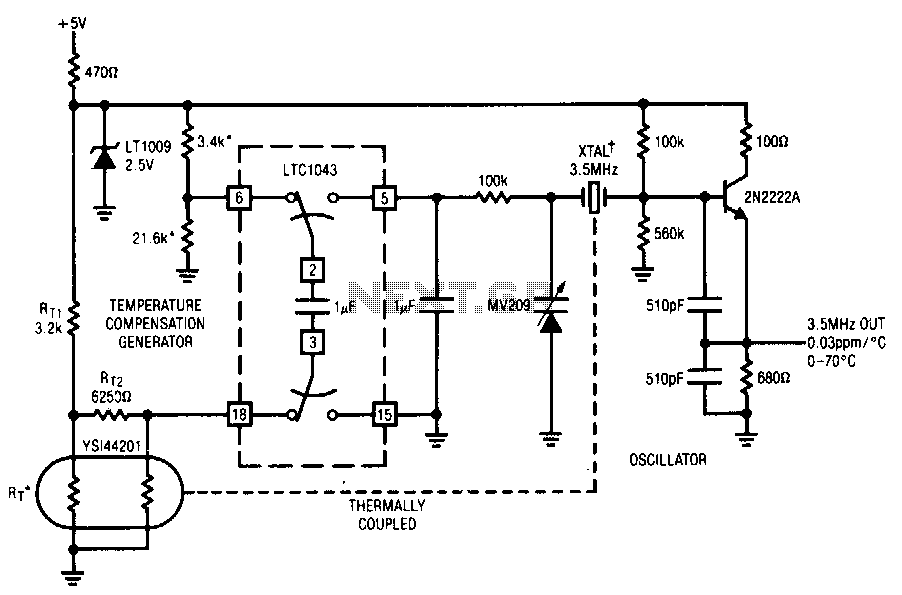
Temperature-compensated-crystal-oscillator

This circuit employs the LTC1043 to distinguish between a temperature sensing network and a de reference. The single-ended output biases a varactor-tuned crystal oscillator to compensate for drift. The varactor crystal network exhibits high de impedance, negating the necessity for an LTC1043 output amplifier.
The circuit utilizes the LTC1043, a precision instrumentation amplifier, to accurately differentiate between the signals from a temperature sensing network and a reference voltage. The LTC1043 is known for its low offset voltage and high common-mode rejection ratio, making it suitable for applications requiring precise measurements. In this configuration, the LTC1043 converts the differential voltage from the temperature sensor into a single-ended output.
The single-ended output of the LTC1043 is connected to a varactor-tuned crystal oscillator. The purpose of this oscillator is to maintain frequency stability despite temperature variations, which can cause drift in oscillator performance. The varactor diode, which is a voltage-controlled capacitor, allows for tuning of the oscillator frequency by adjusting the bias voltage applied to it. This tuning capability is essential in applications where precise frequency control is necessary.
The crystal network associated with the varactor exhibits a high de impedance, which is beneficial as it reduces the loading effect on the oscillator circuit. This high impedance characteristic eliminates the need for an additional output amplifier from the LTC1043, simplifying the overall circuit design and enhancing reliability. By minimizing the number of components, the circuit not only becomes more compact but also reduces the potential points of failure, thereby improving overall performance and stability.
In summary, this circuit design effectively combines the LTC1043 with a varactor-tuned crystal oscillator to achieve a robust solution for temperature compensation in frequency-sensitive applications. The careful selection of components and their arrangement ensures high performance and reliability in varying environmental conditions.This circuit uses LTC1043 to differentiate between a temperature sensing network and a de reference. The single-ended output biases a varactor-tuned crystal oscillator to compensate drift. The varactor crystal network has high de impedance, eliminating the need for an LTC1043 output amplifier. 🔗 External reference
The circuit utilizes the LTC1043, a precision instrumentation amplifier, to accurately differentiate between the signals from a temperature sensing network and a reference voltage. The LTC1043 is known for its low offset voltage and high common-mode rejection ratio, making it suitable for applications requiring precise measurements. In this configuration, the LTC1043 converts the differential voltage from the temperature sensor into a single-ended output.
The single-ended output of the LTC1043 is connected to a varactor-tuned crystal oscillator. The purpose of this oscillator is to maintain frequency stability despite temperature variations, which can cause drift in oscillator performance. The varactor diode, which is a voltage-controlled capacitor, allows for tuning of the oscillator frequency by adjusting the bias voltage applied to it. This tuning capability is essential in applications where precise frequency control is necessary.
The crystal network associated with the varactor exhibits a high de impedance, which is beneficial as it reduces the loading effect on the oscillator circuit. This high impedance characteristic eliminates the need for an additional output amplifier from the LTC1043, simplifying the overall circuit design and enhancing reliability. By minimizing the number of components, the circuit not only becomes more compact but also reduces the potential points of failure, thereby improving overall performance and stability.
In summary, this circuit design effectively combines the LTC1043 with a varactor-tuned crystal oscillator to achieve a robust solution for temperature compensation in frequency-sensitive applications. The careful selection of components and their arrangement ensures high performance and reliability in varying environmental conditions.This circuit uses LTC1043 to differentiate between a temperature sensing network and a de reference. The single-ended output biases a varactor-tuned crystal oscillator to compensate drift. The varactor crystal network has high de impedance, eliminating the need for an LTC1043 output amplifier. 🔗 External reference
Warning: include(partials/cookie-banner.php): Failed to open stream: Permission denied in /var/www/html/nextgr/view-circuit.php on line 713
Warning: include(): Failed opening 'partials/cookie-banner.php' for inclusion (include_path='.:/usr/share/php') in /var/www/html/nextgr/view-circuit.php on line 713